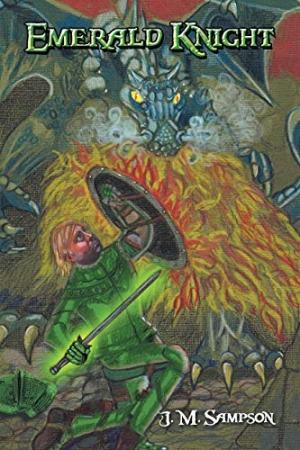Emerald Knight
Sorcerers, ancient dragons, and careful showdowns make this morality tale fascinating.
In J. M. Sampson’s historical fantasy of heroic proportions, Emerald Knight, a knight with rigid morals protects innocents and thwarts evil.
In the land of Valeria, a stoic knight swears oaths to those who request his aid. Germaine of Scot Hold—better known as the Emerald Knight—dreams of a time when the land will know only peace. Germaine’s most recent oath is to protect Lady Estrella Merelda of the nearby kingdom of Lyon Hold, against whom stands a powerful sorcerer with aspirations of conquering Valeria. Germaine’s moral code necessitates that he face an ancient, massive enemy once thought eradicated: dragons.
Germaine is a fascinating relic, even within the aged setting of Valeria. He is unflinching in adhering to his perceived duties, even when he has to leave his wife and family behind for long stretches of time to do so. His interactions reveal that most other people are familiar with his renown, as well as with the fact that he finds it difficult to leave home.
Mixing alternative historical elements with fantasy and medieval politics, the book at first does not seem set on Earth, though subtle clues point to the world beyond Valeria: Germaine wears a Christian icon; someone refers to the land as Terra; a magician mentions Camelot. These connections are intriguing.
As Germaine realizes that he’s taken on too much, the story tracks his slow travel and gathering of information in a realistic way. It takes a few days for an army to reach a castle, for example, so Germaine and his allies devote the time they spend waiting to training for the battle ahead. Germaine instructs the castle’s forces, too, eschewing traditional tactics for ones drawn from his experience in similar battles. Meanwhile, a romance develops between Germaine and Lady Estrella; both attempt to put their feelings aside and focus on defeating the sorcerer nonetheless.
The book is paced in such a way to make room for alternate perspectives on key scenes: Germaine, Lady Estrella, and an allied magician all speak. Stilted, overly formal conversations befit the book’s era and style. Germaine’s bold, commanding voice is consistent, while Lady Estrella’s straightforward tone captures her character well. Other characters’ mannerisms, as with a magical owl who speaks with a cocky tone, make the work more dynamic.
The satisfying conclusion includes a sorcerer and an ancient dragon, layering last minute world building upon the text and establishing connections with familiar myths. Emerald Knight is a compelling moral epic that blends mythologies with fantastical elements.
Reviewed by
John M. Murray
Disclosure: This article is not an endorsement, but a review. The publisher of this book provided free copies of the book and paid a small fee to have their book reviewed by a professional reviewer. Foreword Reviews and Clarion Reviews make no guarantee that the publisher will receive a positive review. Foreword Magazine, Inc. is disclosing this in accordance with the Federal Trade Commission’s 16 CFR, Part 255.

